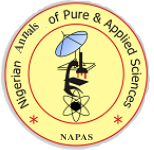Antiplasmodial activities of the combined leaves extracts of Morinda lucida, Phyllantus Amarus, Vernonia Amygdalina and Newbouldia laevis
DOI:
Keywords:
Antiplasmodial, oxidative enzymes, plant extractsAbstract
The development of resistance to some synthetic antimalarial drugs and the spread of counterfeit antimalarial drugs, has become a global problem. It has affected effective malaria treatment, making the development of new drugs exigent. Certain medicinal plants contain potent ingredients such as alkalloids, flavonoids, glycoside and volatile oils, which suppress the spread of plasmodial infections, and are widely used within the tropics for treatment of malaria. This study was designed to investigate the antiplasmodial activities of the combined aqueous extract of Morinda lucida, Phyllantus amarus, Vernonia amygdalina and Newbouldia laevis at variable doses in Swiss albino mice infected with Plasmodium berghei (NK65). Fifty mice were randomized into ten groups which were divided equally for suppressive and curative test. Four days suppressive and 5 days curative test were used to assess the antiplasmodial activities of the extract in mice infected with chloroquine sensitive P. berghei at concentration of 200mg/kg, 400mg/kg and 800mg/kg body weight. Furthermore the levels of aspartate aminotransferase (AST), alanine aminotransferase (ALT) and alkaline phosphate (ALP), urea and creatinin were determined by standard procedural methods to evaluate impact of extracts on hepatic and kidney function. The results of the 4 days suppressive test revealed that the test extract achieved percentage suppression of 9.8%, 58.3% and 60.2% for 200mg/kg, 400mg/kg and 800mg/kg concentration respectively. The curative test achieved the highest parasitaemia reduction with 800mg/kg (29.5±29.1 x 103) which was comparable to the standard antimalarial drug, chloroquine. There were significant elevation in the values of AST and ALT at 400mg/kg and 800mg/kg respectively suggesting hepatic dysfunction. However, ALP and urea showed no significant different (P>0.05), but creatinin showed significant difference (P<0.05) only at 200mg/kg. This study shows that the combined leaves extract demonstrated antimalarial activities.



 Contact Us
Contact Us Editorial Team
Editorial Team Join As A Reviewer
Join As A Reviewer  Request For Print Copy
Request For Print Copy


 Cprint Publishers
Cprint Publishers